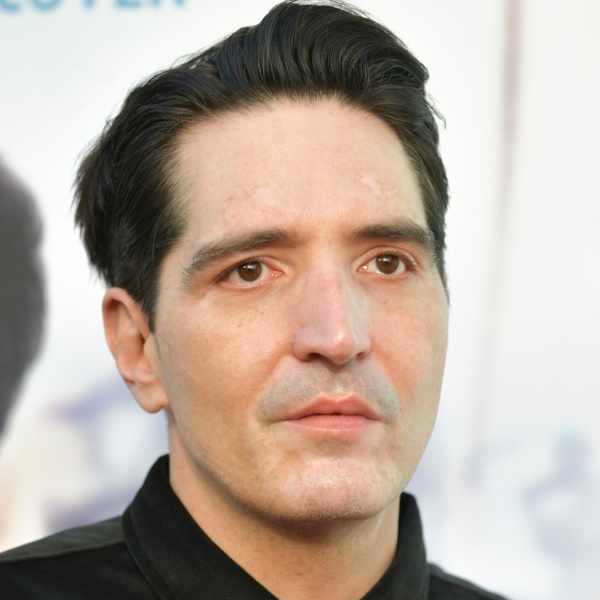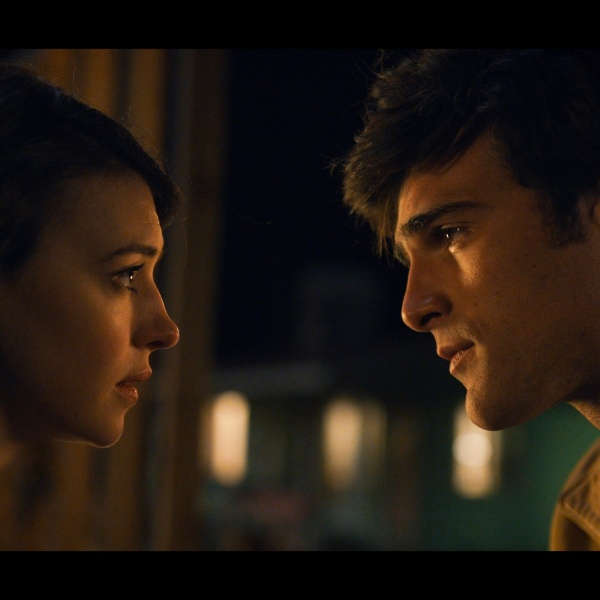One thing we know for certain: Tony Scott is bold to the point of absurdity.
How else to explain how Tony (once thought of as a slicker, more sensationalistic version of his older brother and producing partner Ridley) went from being the go-to guy for straightforward, big budget pop entertainments, to someone who, while still playing in the same, mega-canvas studio scale, has created works of increasing weirdness. He started out as a filmmaker whose sole intent was to pump up the volume, max out the sizzle, and drape all of his actors in fabulous clothes. These days, he boldly and fearlessly experiments, creating multiplex fare that is disorienting, abrasive and occasionally, genuinely cutting-edge. Unlike his more critically revered brother, Tony isn’t keen on creating imagined worlds, instead preferring to investigate, very much, the here and now. There’s an immediacy to his films that you can practically feel, a rawness that betrays the obvious stylization that goes into crafting each arty frame. Tony seems to bring out the craziness in his collaborators too (John Travolta used the word “bunghole,” an expression last heard on “Beavis and Butthead,” in last summer’s “The Taking of Pelham 1 2 3”), and his entire creative operation seems fast and loose, hung together by raw enthusiasm and a willingness to test technical and artistic bounds, no matter how fucking outrageous it may seem.
So, on the eve of “Unstoppable,” his second runaway train movie with Denzel Washington in two years (who would even attempt such a thing?), we look back at the filmmaker who, while not always succeeding, certainly knows how to push things in some very extreme directions.
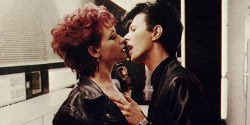 “The Hunger” (1983)
“The Hunger” (1983)
While today’s Tony Scott may have reached the decadent apex of his visual output with “Domino,” and has scaled back somewhat in recent years, the Scott of 1983’s “The Hunger” was more than a counterpart to his brother Ridley, but a genuine auteur announcing his entrance. “The Hunger” is a film both assured and ambitious, wringing subtlety and slow-boiling tension out of a shamelessly ridiculous plot involving a vampiric vixen that has persisted since Ancient Egyptian times in the graceful form of Catherine Deneuve, with lover David Bowie (showing off rarely seen but always appreciated dramatic chops — this ties with “The Prestige” for his best supporting turn) riding her coattails through the veins of time. When Deneuve’s Miriam Blaylock takes an interest in researcher Sarah Roberts (Susan Sarandon), Bowie’s John begins a gracelessly rapid descent into advanced age and seeks the help of Roberts, who happens to study premature aging (only in the movies, folks!). Scott keeps a firm handle on his stylistic flourishes, with Stephen Goldblatt’s noirish lighting an invaluable assist. “The Hunger” is a vampire film that could just as easily be a study of lust, love, and the waste that either lays on the body. Scott may be accused of almost exploitatively turning up the heat in the infamous lesbian scene between Deneuve and Sarandon, but like the rest of the film, even the juicy bits are handled with the kind of restraint that may have been the director’s trademark had “The Hunger” been a runaway hit. Alas, the film is too strange, too dark and burdened with a vexing finale. It is also one of the best vampire films ever made, a fable that toes the line between a fairy tale and a blood bath, occasionally (and expertly) mixing both. An assured debut, although an unfortunate box office burn for Scott, “The Hunger” is well deserving of its sizable cult following. [B+]
 “Top Gun” (1986)
“Top Gun” (1986)
At this point in our culture, it’s impossible to discuss “Top Gun” with any amount of clear-eyed objectivity. The film is a milestone for all of its key contributors. For director Tony Scott, it’s his early-career masterpiece (it’s also the film that got him out of director jail after his debut, “The Hunger”). For producers Don Simpson and Jerry Bruckheimer, it was the movie that truly solidified them as the uber-producers of the 1980’s. And for star Tom Cruise, it was his first runaway blockbuster sensation, his first taste of global superstardom, and the film that made him a household name. “Top Gun” is a product of its time in a way that so few films can claim to be. Released in the summer of 1986, the film played on the still-lingering fears of war with the Soviets and carried a rah-rah, jingoistic spirit that seems laughable nowadays but probably felt very honest at the time of release. It feels pointless to rehash the plot of “Top Gun” – anybody with a pulse has seen it and knows all about Maverick, Goose, Iceman, Jester, Charlie and the rest of the crew. Sure, the scenes on the ground pale in comparison to the ones up in the air (Jeff Kimball’s gorgeous cinematography is still a lesson in perfection) and most of the dialogue is cheesily pedestrian. But that’s not the point of “Top Gun.” The film is all about machismo and how men deal with expectations, loss, tragedy, acceptance and success. Those classic scenes in the shower (or during a particular game of beach volleyball) seem homoerotic in hindsight (and maybe they did upon first glance…), but what they’re really about is men trying to one up each other, trying to figure out how to best your opponent, and always remembering that there are no points for second place. To say that “Top Gun” is one the manliest movies ever made would be understatement; you can practically smell the testosterone. That’s what’s so fun about it. And when you add in the ridiculously quotable one-liners (who knew that rubber dog shit originates from Hong Kong?) and the high-flying airborne camerawork (still unmatched to this day), then it’s no wonder that the film plays every single weekend on TNT and has become one of the most influential and iconic movies ever made. And if you’re not a fan of “Top Gun,” then just remember, the plaque for the alternates is in the ladies’ room. [A]
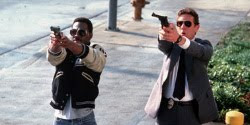 “Beverly Hills Cop II” (1987)
“Beverly Hills Cop II” (1987)
The first “Beverly Hills Cop,” directed by Martin Brest and starring a sensational Eddie Murphy, was a comedy with slivers of action, while the sequel, directed with muscular intensity by Mr. Scott, feels much more like an action movie sprinkled lightly with comedic elements. A lot of the movie feels familiar (the original script was set overseas but Murphy didn’t want to travel) and rushed (it was on an unfathomably tight release schedule), but the movie has some wonderful, utterly Scott-ian stylistic tics. Take, for instance, the cramped Detroit police station with its neverending battery of fans (he loves things to be moving in the background) and lighting that seems to cut through a small cluster of indoor cumulonimbus clouds (the man loves to smoke up a room). Also, in the final showdown Murphy has with the assorted villains, Scott chose to stage the thing in a kind of open warehouse, which in his hands feels more like a charnel house with gauzy strips of fabric hanging from the ceiling. It’s a bizarre, eerie, otherworldly set and one that only Scott could have plopped into a movie called “Beverly Hills Cop II” and made work. What’s most interesting about the movie, though, could be the collision of styles between Murphy and Scott: you can tell that every sequence, every shot, was tightly controlled by the director while the star wanted nothing more than to endlessly riff. Somehow, it works, and makes for the most compelling entry in the franchise. [B+]
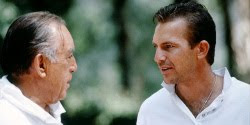 “Revenge” (1990)
“Revenge” (1990)
A bleak, violent, sexy-as-hell thriller, “Revenge” is one of Tony Scott‘s true masterpieces. Since “Revenge” has a number of truly surprising twists and turns, we’re going to go light on the plot specifics, but will say that Kevin Costner is an ex-aviator who goes to Mexico at the request of his old friend (played by Anthony Quinn, with his “menace-o-meter” turned up to 11). Said friend has a young wife (Madeleine Stowe) who Costner just cannot resist. What follows is a brutal revenge tale that feels, in many superficial and spiritual ways, like Scott’s lone Western. Scott has an unflinching eye when it comes to both sexuality and violence, which turned off a lot of viewers when it was initially released (and befuddled the film’s producers). In the years since, Scott has constructed a more streamlined “director’s cut” for home video, which, surprisingly, comes in at about 20 minutes shorter than the theatrical exhibition. There are a number of reasons to watch and adore “Revenge,” from Costner’s conflicted performance to Jack Nitzsche’s score and the sun-bleached cinematography from Jeffrey Kimball. “Revenge” is Tony Scott’s most mournful and humane story, a film that is stylistically admirable but, above all else, emotionally engaging. The fearlessness with which Scott stages the film’s finale will leave you breathless; an unheralded masterwork and the most compelling argument against stuck up cineastes who claim the director is “just some flashy hack.” [A-]
 “Days of Thunder” (1990)
“Days of Thunder” (1990)
What was billed as an epic re-teaming of the “Top Gun” principals (producers Don Simpson and Jerry Bruckheimer, star Tom Cruise) was a financial and critical boondoggle. But that still doesn’t mean it shouldn’t be canonized, at the very least for introducing the phrase “monkey fucking a football” into our impressionable young lives. And despite its tarnished image, it’s a movie that’s just as interesting as “Top Gun,” if not more so. Watch, for instance, how when faced with the relative starkness of the NASCAR racetrack, Tony Scott‘s love of background motion translates into a hypnotic fascination with the flags that line the track. Also, Scott’s love of masculine rivalry is taken to an extreme level in the competitive relationship between Cruise’s Cole Trickle (titter) and Michael Rooker’s Rowdy Burns (titter again). These two guys can’t wheel down a hospital hall or drive to a shared meeting without some kind of high-octane race breaking out. At some point you expect them to free their penises from their racing getups and just compare size (probably, knowing Scott’s proclivity, in a room filled with atmospherically gauzy smoke). What’s striking, watching this in the post-“Talladega Nights” climate, is how strictly Adam McKay’s surrealist racing comedy sticks to the “Days of Thunder” structure. And what’s more, “Nights” co-star John C. Reilly has a small role in Scott’s film, making him the undisputed king of NASCAR cinema. [B]
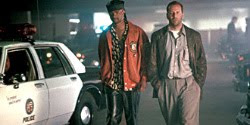 “The Last Boy Scout” (1991)
“The Last Boy Scout” (1991)
Friday night’s a great night for football in Tony Scott’s thriller. Involving a tangled conspiracy with elements of score-fixing, political scandal, murder and pigskin, “The Last Boy Scout” ranks highly amongst action pictures of that era. Part of that comes from Shane Black‘s almost-too-witty script, showcasing a universe where every tense life-or-death situation can be defeated with a punch and a quip. And don’t be misinformed: this is one quip-heavy picture– a profane, misogynist noir with a pitch black cynicism that showcases characters trying to maintain some semblance of sanity in a world where they remain at the mercy of an overwhelming patriarchy. Bruce Willis, all squinty sarcasm, is matched blow-for-blow by a game Damon Wayans, neither character reduced to buddy movie, comic relief or tough guy archetypes, but both inclined to comment on them. To his credit, Scott hasn’t made a film half as funny since. [B]
 “True Romance” (1993)
“True Romance” (1993)
Were it not for Quentin Tarantino’s excellent screenplay for “True Romance,” in many ways his own version of Terrence Malick’s “Badlands” (hammered home by Hans Zimmer’s riffing on its use of Gassenhauer for the theme), this writer would be unable to champion anything in Tony Scott’s oeuvre. His style, especially from “Enemy of the State” and on, is akin to what Baz Luhrmann does. It simply grates on the senses, punishes the brain with relentlessness, and too often feels like smoke and mirrors, as if Scott never trusts his material enough to let the camera just capture a moment. Not so with “True Romance,” thankfully made well before his move into gonzo stylistics. The pairing of screenwriter and director here (which didn’t work so well for Richard Kelly in “Domino,” unfortunately) is a good fit, with a plethora of memorable characters and dialogue, most notably Brad Pitt’s honey bear bong-smoking pothead and the legendary face off between Dennis Hopper and Christopher Walken (“You got me in a vendetta kinda mood”). The original ending was changed by Scott, and for the better; Clarence (Christian Slater) died in the end of Tarantino’s script, which wasn’t necessary. Proof that Scott has the ability to make wise directorial choices, if only he’d get back to that instead of all the flashy, annoying bullshit he’s so enamored with these days. [A-]
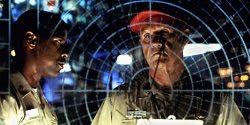 “Crimson Tide” (1995)
“Crimson Tide” (1995)
Yes, “Crimson Tide” is a Tony Scott film, very much so. But it may be remembered these days, at least to the obsessive film geeks of the world, for the contributions of uncredited co-writer Quentin Tarantino. Tarantino, a longtime Scott fan, was called in to punch up the dialogue after “True Romance” on this certifiably great submarine thriller that pits Denzel Washington against the power-mad captain played by Gene Hackman. The scenes that bare Tarantino’s mark might as well be highlighted in blinking neon lights: an early scene in the film where the various crew members talk about their favorite submarine movies (in a wonderful bit of meta-textual knowingness); a discussion about which version of the Silver Surfer is better; and Hackman rattling on endlessly about different breeds of horses, a speech which has the flow of the famous “Sicilian” speech in the pair’s earlier collaboration. As far as submarine movies go, “Crimson Tide” does a sturdy job: Scott choreographs the suspense sequences brilliantly (aided by claustrophobic cinematography by Dariusz Wolski) and emphasizes that the close-knit camaraderie that forms underneath the ocean can just as quickly curdle into something quite dangerous. It’s also worth noting Scott’s often unheralded genius at casting. Tucked beneath and around the cramped submarine sets are actors like James Gandolfini, Viggo Mortensen, Steve Zahn, and Ryan Phillippe. The ominous score by Hans Zimmer, while not quite as enthralling as Basil Poledouris’ work for “The Hunt for Red October,” was still enough to net the composer a Grammy for his work. [B+]
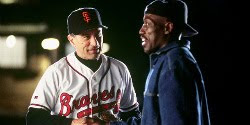 “The Fan” (1996)
“The Fan” (1996)
Say this for Tony Scott’s laughable suspense thriller: it improves upon the tawdy, overblown Peter Abrahams source material. Credit goes to the hyper-caffeinated director, who clearly knows how to mock the dead-serious atmosphere of the sports media, with Ellen Barkin as the overheated Ahab-with-a-notepad going after star athlete Wesley Snipes. Where it slips up is the portrayal of psycho fan Robert De Niro, who slowly sees his life unraveling as his favorite player struggles to acclimate to his new surroundings. As superstar Bobby Rayburn, Snipes is both a believable athlete and a credible dramatic presence, struggling under the weight of Barry Bonds-level expectations. But Scott’s attempts to get into De Niro’s inner turmoil by switching filters and blaring Nine Inch Nails on the soundtrack aren’t exactly on the level of “Taxi Driver”. “The Fan” remains a curiosity in that it revealed Scott’s strengths in capturing the insane milieu of professional sports in lieu of insight into the mind of the average man. [C]
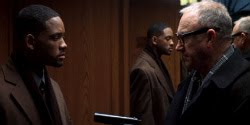 “Enemy of the State” (1998)
“Enemy of the State” (1998)
Political thrillers don’t get much more live-wire and jacked-up than “Enemy of the State,” a shiny, cool-blue, lightning-fast “man-in-the-wrong-place-at-the-wrong-time” movie which served as a critical and box-office comeback for Tony Scott after the drubbing he took for “The Fan”. Mixing “The Conversation” with “The Parallax View” and adding in a few terrific car and foot chases with some stylish shoot-outs, “Enemy of the State” was the fifth collaboration between Scott and producer Jerry Bruckheimer, and marked a more dramatically serious trend for the producer (films that immediately followed ‘Enemy’ included “Remember the Titans,” “Black Hawk Down,” and “Veronica Guerin”). Will Smith, fresh off the mega-success of “Independence Day,” was perfectly cast as a hot-shot lawyer who inadvertently comes into possession of a video showing an evil U.S. Senator (Jon Voight, appropriately oily) masterminding a murder. Smith teams up with a reluctant ex-spook (Gene Hackman, terrific as always, doing a riff on his immortal character from “The Conversation”) and goes head-to-head with the NSA in an effort to clear his name. The pacing of “Enemy of the State” is unbelievable as images and plot are hurled at the viewer. But what’s amazing about that approach is that everything can be followed logically and coherently despite the frenetic nature of the filmmaking style. Scott, working with cinematographer Daniel Mindel (who also shot Scott’s aesthetically groundbreaking “Domino”), put cameras in every corner of the room in “Enemy of the State,” mixing various film speeds and stocks with an overall high-contrast, desaturated visual palette, resulting in a film that feels icy-hot to the touch. The camera never stops moving, never slows down, and never gets tired; it’s energetic filmmaking to the max, especially when set to the rhythms of Harry Gregson-Williams’ pulsating musical score. By the time the film reaches its thoroughly clever finale, in which Scott even cribs from himself (“True Romance,” anyone?!), you can’t help but feel out of breath and exhilarated. [B+]
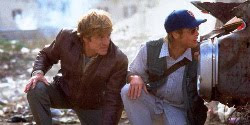 “Spy Game” (2001)
“Spy Game” (2001)
What might be considered Tony Scott‘s last “straight” movie (read: not batshit), “Spy Game” is an unbelievably compelling tale of a retiring CIA Agent (Robert Redford) who has to use every trick in his not-inconsiderable playbook to successfully free an imprisoned agent (Brad Pitt) who also happens to be his protégé and close friend. Oh, and all of this on his last day of work. Nobody does the “ticking clock” quite like Scott, who installs not only a dramatic freeze frame but also a time stamp that practically smashes the screen apart. It’s a fitting stylistic flourish, though, for a film that’s all about time: the film shifts back and forth, liberally, from the modern day stuff with Redford running around his high tech office trying to make amends, cash in every favor he’s collected, and block his superiors’ boneheaded attempts at diplomacy, to various sequences of Pitt and Redford throughout their career (Vietnam, Cold War, etc). It’s in these flashback sequences that Scott really shines, tasked with the double duty of creating captivating suspense set pieces while also delivering important character beats, and he pulls it off marvelously. While by no means a classic, it remains an under-seen gem, an intoxicating mix of spy-versus-spy conspiratorial atmosphere and Scott’s go-for-broke edge-of-your-seat excitement that beats, for sheer white-knuckle intensity, the entire run of “24.” [B]
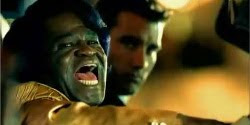 “Beat the Devil” (2002)
“Beat the Devil” (2002)
Tony Scott’s late-career, ultra-impressionistic style took root with the gloriously hyperactive “Beat the Devil,” his contribution to the BMW film series, “The Hire,” which was a series of extended BMW commercials in the guise of slick and exciting short films with serious Hollywood pedigree. The talent in front of and behind the camera on “The Hire” was staggering. Directors included John Woo, Wong Kar-Wai, Joe Carnahan, Ang Lee, Alejandro González Iñárritu, Guy Ritchie, John Frankenheimer and Scott with an acting lineup featuring the likes of Don Cheadle, Mickey Rourke, Madonna, Stellan Skarsgård, F. Murray Abraham, Ray Liotta, Dennis Haysbert, Maury Chaykin, and Marilyn Manson. And for those of us who hoped to see Clive Owen as the next James Bond, we’ll always have “The Hire,” where he plays the nameless Driver, an expert behind the wheel (always a BMW, naturally) who is tasked with various life-threatening missions with differing degrees of difficulty. The one linking thread between the different films, Owen brought a manly command to the lead role that helped solidify the entire series. “Beat the Devil” is the most out-right entertaining film of the bunch, and it’s the one that seems to be having the most fun. It centers on the idea that James Brown (who played himself), back in his youth, sold his soul to the Devil (a hysterical Gary Oldman in make-up and costume that has to be seen to be believed) in exchange for the chance to have a legendary career. But now that the rocker is getting old, he wants to renegotiate the terms of his deal so he can go back to being young, so he suggests that his Driver (Owen) will race Lucifer’s driver, Bob (Danny Trejo), from the Vegas strip out into the desert. Winner takes all. For roughly 10 minutes, Tony Scott makes cinematic rock ‘n’ roll love to his camera; every image is cranked, every sound effect is juiced, every edit is sharp as a tack. His fragmented, cubist style that would be seen in future efforts like “Man on Fire” and “Domino” was being first experimented with here (overlapping subtitles, a washed out and desaturated color scheme, staccato editing patterns and skewed camera angles). “Beat the Devil” exists primarily as a sensory blast but it’s also got a great sense of humor, probably the best sense of humor out of any of the movies in “The Hire,” which is why it’s one of our favorites. [B+]
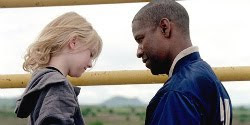 “Man on Fire” (2004)
“Man on Fire” (2004)
Released in spring 2004, “Man on Fire,” a remake of a Scott Glenn actioner, arrived in the midst of a revenge picture mini-renaissance. Sandwiched between “The Punisher” and “Kill Bill Vol. 2,” Tony Scott’s action movie vocabulary definitely left an impression. At the heart of his experimental phase, “Man on Fire” mangles and rearranges a standard direct-to-DVD plot about a disillusioned mercenary forced to take up arms against crooked kidnappers in the hellhole of Mexico City. With local law enforcement useless, Denzel Washington becomes the modern Mandingo in a post-9/11 world, standing shoulder-to-shoulder with the criminal element to return lilywhite Dakota Fanning to Radha Mitchell in spite of her crooked Hispanic husband Marc Anthony. Scott’s belligerent editing and action movie vocabulary suffers at the hands of a traditional revenge narrative, one that feels the need to spend a good half hour of Denzel’s Good Negro befriending the diminutive Fanning, but opts for restraint in obscuring the visual of Mickey Rourke beheaded by a samurai sword. Oooh, too harsh? Maybe, but the film’s queasy, deeply questionable racial politics are as much a distraction in the film as Scott’s inept visual blitzkrieg. [D]
 “Domino” (2005)
“Domino” (2005)
Perhaps the apogee of Tony Scott’s off-the-rails-ness and perhaps the closest thing he has ever made to Oliver Stone’s “Natural Born Killers,” “Domino ” is either the height of cinema or the the near willful destruction of it, depending on your point of view. Loathed by most, and adored by a select few (including one of our writers here, who we had to pin down and not let write this review), perhaps another reason it’s completely absurd is that it’s written by filmmaker Richard Kelly (“Southland Tales,” “The Box”), who now seems incapable of making a coherent film (and indeed, who took the magic right out of “Donnie Darko,” and perhaps revealed himself to be a charlatan with the release of the far-worse TMI director’s cut). Onto the film itself, which has an early post-career rehabilitiation performance by Mickey Rourke and is wise enough to utilize the great Edgar Ramirez pre-“Carlos.” It also makes a poor decision in casting Keira Knightley as the lead, a supposed-to-be-tough bounty hunter. More importantly, the film has cinematic autism/dyslexia and basically barfs up every piece of film technique grammar known to man on the screen, with a particular fondness for green/yellow filters, for no apparent reason. Visually, it’s a mess and it feels like an ADD nightmare come to life: just too much damn style (you’ll see the reverse argument herein somewhere). Kudos to some of the too-ridiculous-it’s-funny comedy, including the “90210” and DeVry institute references, plus Mo’Nique who is just pretty damn hysterical in her non-sequitur cameo about creating new racial profiles (Chi-Negroes is our fave). So some points for just batshit lunacy, but otherwise, kind of one of the worst films ever made… and the most brilliant. [D]
 “Déjà Vu” (2006)
“Déjà Vu” (2006)
Tony Scott‘s kicky time-travel thriller seemed doomed from the outset: originally set to film in and around New Orleans, Katrina struck and all but shattered those plans. Eventually, the film regrouped and the city rallied to have filming return to the bayou city, with frequent collaborator Denzel Washington playing an investigator who gets involved in high-tech surveillance (and later, with dubious scientific backing, time travel) to stop a terrorist from blowing up a tourist-filled ferry. Of course, the drama didn’t stop after the film was completed and released, with both credited writers taking to the Internet and badmouthing the director, saying that he was less interested in plot cohesion than he was in getting the detonation details just right. To which we say: duh. Scott, working from a similarly wiry, conspiratorial place as “Enemy of the State,” does a great job creating a sense of working class sci-fi, in which a bunch of dudes sit around a room and dream this shit up. Of course, his stylistic embellishments are even more pronounced in the playing field of science fiction, the greatest example of which is a car chase that takes place across two dimensions at the same time. There’s also a kind of perverse genius in casting Jim Caviezel, the artist formerly known as Jesus, as a deranged terrorist killer. But unlike the disgruntled screenwriters, we think that the film’s ambiguities and loopholes make for compelling speculation and post-film discussion. “Déjà Vu” may not be as tight as it could have been, but it is just as fun. [B]
 “The Taking of Pelham 1 2 3” (2009)
“The Taking of Pelham 1 2 3” (2009)
Bloody, gritty, profane, and obsessively stylish, Tony Scott‘s hostage/hijacking tale “The Taking of Pelham 1 2 3” is more than up to the task of re-imagining its source material (Joseph Sargent’s 1974 original film which itself was based on an original novel by John Godey). Scott’s version is crisply written and wonderfully efficient (Brian Helgeland gets screenplay credit and does a crafty, tight job with uncredited help from David Koepp) with juicy performances from Denzel Washington as the morally conflicted hero and a sneering, bald, tattooed, and constantly cursing John Travolta in one of his best performances as the psychopathic villain. It’s quite clear Travolta was having a blast; he’s in “Face/Off” territory here. “The Taking of Pelham 1 2 3” isn’t an awards movie and it’s not the sort of film that appeared on a ton of top 10 lists. It’s just a souped up genre film made with extreme skill by a director in love with his craft. Scott takes a well-worn narrative (the hostage crisis thriller scenario) and amps up the thrills and excitement with sexy cinematography (by Tobias Schleisser, a Peter Berg regular) and flashy editing techniques (Chris Lebenzon, the action genius behind “Top Gun,” “Crimson Tide,” “Enemy of the State,” and “Pearl Harbor”), which makes for a fast-moving piece of hard-edged, R-rated entertainment. [B]
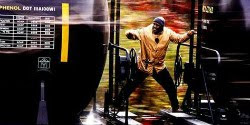 “Unstoppable” (2010)
“Unstoppable” (2010)
Tony Scott needs his ritalin, Tony Scott has ADD, Tony Scott is schizophrenic and needs mental help. Hell, we’ll be the first to admit that we’ve lobbed a lot of these criticisms at Scott’s frenzied, unhinged and sometimes just inanely over-edited and manic form of cinema. But we’ll also be the first to admit that his latest train movie (that’s two in a row) is an exhilarating experience, his best film since “Enemy of the State,” and finally uses his kinetic/fruitcake camerawork strengths in the name of good instead of evil. Possibly one of the biggest assets of the film is a lack of a villain. In his sometimes cartoonish films, the antagonists are almost always laughable caricatures. Here, the only evildoer is human error and a faceless train that’s rolling out of control and threatening to decimate a rather big and populated town. Other advantages include over-the-top Fox News reports, oily corporate assholes making margin-loss based decisions, and goofball, inept track workers who precipitate this entire mess. Usually these plot devices in Tony Scott films are black-and-white and make your eyes roll because they’re so forced. Here, they’re a form of delightful comedy and often so ridiculous, they’re a good laugh. Big, dumb, thrilling fun — plus simply just genuinely nail-biting and intense — “Unstoppable” is an undeniably enjoyable film and hopefully a track that Scott continues on from here on in. [B+]
— Drew Taylor, Rodrigo Perez, Nick Clement, Mark Zhuravsky, Gabe Toro, Erik McClanahan,



